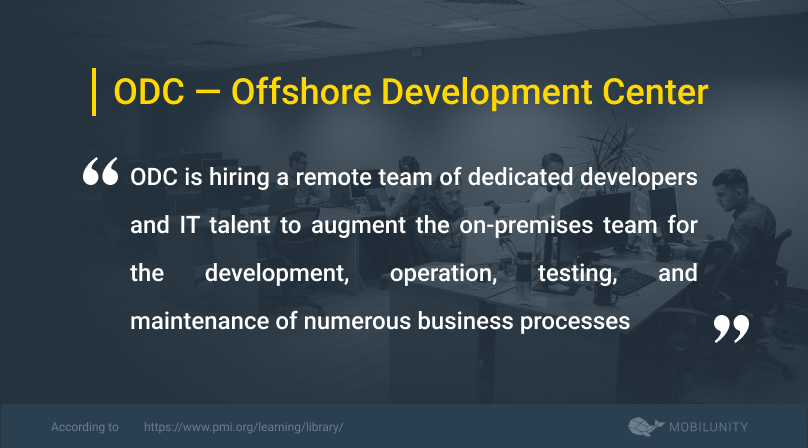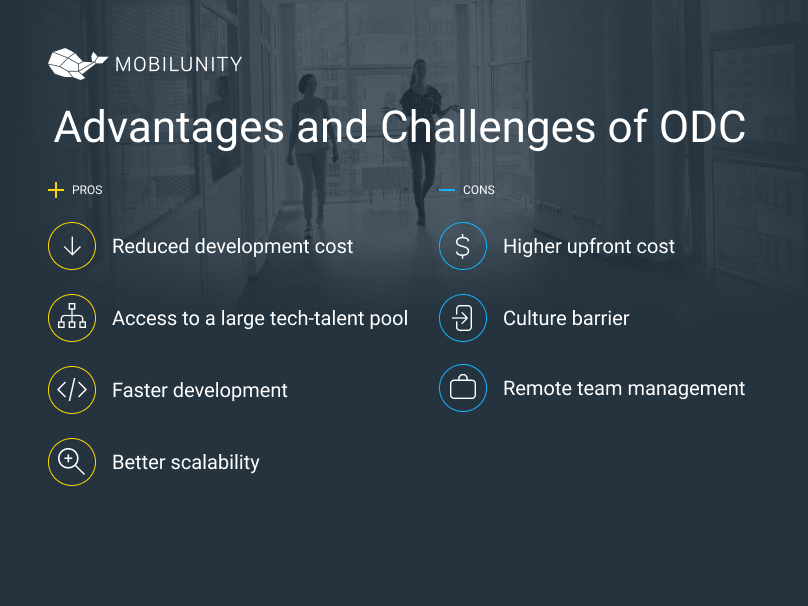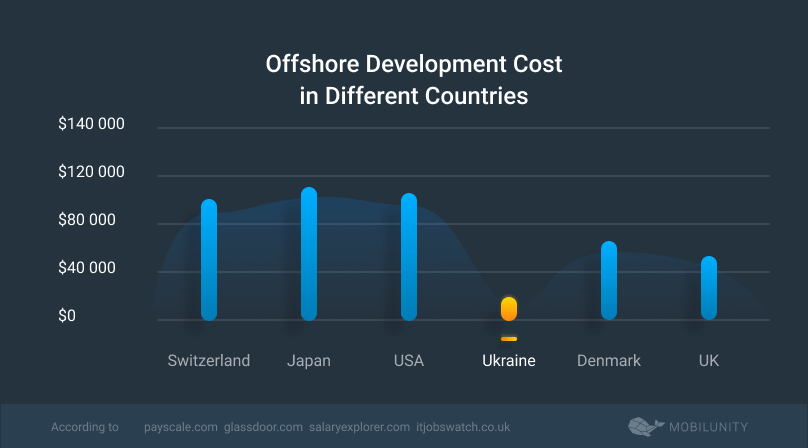ODC (Offshore Development Center)

In order to supplement the on-premises team for the purpose of developing, operating, testing, and maintaining a variety of business processes for a client company that is located in a different geographic location, Offshore Development Center (ODC) is in the process of recruiting a remote team of devoted developers and IT talents [1]. The description of an offshore development center (ODC) that was just given provides a clear explanation of the concept of what an ODC is and how it functions for businesses and commercial organizations all over the world. The Outsourcing Development Center (ODC) has developed into a relatively prevalent practice in the modern outsourcing sector.
Brief History of ODC
Several decades ago, the name “ODC” began to develop. For the most part, the ODC definition was connected to the concept of outsourcing the development alone. This concept dates back to the 1960s, when prominent firms in Silicon Valley began establishing their outsourcing centers in the state of Jalisco, Mexico [2]. A moderate amount of growth was made in the outsourcing industry during the 1970s and 1980s; however, the most significant increase in offshoring occurred following the introduction of current internet technology after the year 1990 [3].
In the year 1996, General Electric established its first information technology offshore development center in India. In the years that have passed since then, numerous large firms have begun establishing their research and development centers in various offshore sites such as India, Ukraine, Russia, China, the Philippines, and other countries. One of the most often used methods for outsourcing the development of information technology is the ODC. In the past, models of outsourcing were based on the ad hoc employment of technical personnel, and they were not expressly dedicated to a single customer, project, or job. The ODC IT services model consists of a team of remote engineers who are totally dedicated to their work and who are fully integrated with an on-premises team for the development of information technology.
Dedicated Offshore Development Center Models
The popularity of building a dedicated ODC team for IT development is increasing substantially. Numerous companies are opting for different ODC models that are suitable for their respective business needs. Those custom versions of making an ODC team are based on the needs of the project either from the customer perspective or from the contractor perspective. In general, the building of a dedicated offshore development center can be divided into two major categories [4].
Contractor Model
In this model, the ODC company offers a comprehensive team of IT specialists that are required for a particular project. The process of development is fully performed by the remote team and fulfills numerous tasks and processes, such as planning, designing, developing, testing, and implementing, required to complete a project successfully. This model is very useful for small businesses and startups who need comprehensive development services in a timely manner.
Customer Model
This model of offshore development center costs more than the contractor model. It is widely used by large companies that work in a narrow domain of knowledge. The other major processes like management, analysis, designing, and decision making are performed by the on-premise teams and the offshore team focuses on a particular domain knowledge like coding, testing, or operations.
Global Size of ODC Industry
ODC allows companies to have outsourcing development services to do software development, web design, research, and other crucial operations[5]. The size of the ODC industry is continuously growing due to numerous offshore development center advantages offered to global enterprises. The total market size of outsourcing services worldwide amounts to about $92.5 billion in 2019 [6] about $6.9 billion higher than the previous year. The ODC costs much lesser than on-premises development worldwide, especially in the North American, and Western European countries due to the scarcity of tech-talent, higher living costs, and the competitive market demand. It has been found that more than 80% of the top 500 [5] companies in the world choose to use the ODC model for the development of software and other technical processes. The top two contributors to this industry are the US and Europe respectively. The major sectors that contribute to the ODC industry significantly include IT, healthcare, HR, FinTech, and customer care [7].
Advantages and Challenges of Hiring an Offshore Development Center
Offshore development center ODC has become a gold rush for all types and sizes of enterprises in recent years due to huge cost-saving and productivity. Meanwhile, the enterprises have to face offshore development center challenges that pose a risk to achieve the desired benefits. All enterprises need to cope with those challenges to materialize the upsides of ODC.
The major benefits and challenges of having an offshore development center ODC [8] are given below.
Companies That Used ODC Successfully
Having an offshore development center ODC has been a major attraction for large enterprises for over three decades now. But nowadays, with the evolved model of ODC powered by numerous professional IT companies have opened up new horizons for medium and small enterprises worldwide [9]. With the customized contractor based ODC solutions, many SMBs are opting to open dedicated ODC in the most popular destinations of the world like Ukraine, India, Poland, China, and others.
The major companies that have their dedicated ODC centers in different locations of the world include:
- Apple Inc
- Google Corporation
- Cisco Systems
- Capgemini
- Alibaba Corporation
- Huawei Technologies
- Tencent Corporation
- IBM Corporation
- General Electric Inc
- Microsoft Corporation
- Siemens AG
- Oracle Corporation
- Accenture Corporation
- Tata Consultancy Services
- And many more
ODC Service Cost Comparison
The ODC model of remote development got traction due to the difference in cost in different countries. The countries with lower development costs and larger availability of the tech-talent pool emerged as a popular destination. The average annual salary of an ICT engineer in different countries is mentioned in the following table.
| USA | UK | Switzerland | Denmark | Japan | Ukraine | |
| ($/year) | $104,138 [10] | $47,630 [11] | $99,605 [12] | $68,916 [13] | $111,768 [14] | $14,184 [15] |
The average cost of an ICT engineer in Ukraine is the lowest among all major countries in the USA, Japan, and major European countries.
See Also
References
- https://www.pmi.org/learning/library/managing-talent-offshore-development-centers-1407
- http://newtechmag.net/2018/12/10/the-new-tech-state-of-jalisco
- https://www.slideshare.net/insointernational/offshore-outsourcing-history
- https://mobilunity.com/blog/offshore-development-center
- https://www.iuemag.com/u19/ed/5-benefits-of-choosing-offshore-development-center-in-2019
- https://www.statista.com/statistics/189788/global-outsourcing-market-size
- https://www.statista.com/statistics/189795/global-outsourcing-industry-revenue-by-region
- http://www8.cs.umu.se/education/examina/Rapporter/AtluriNalli.pdf
- https://www.softwaredevelopmentcompany.co/offshore-software-development-companies
- https://www.ziprecruiter.com/Salaries/ICT-Engineer-Salary
- https://www.itjobswatch.co.uk/jobs/uk/ict%20engineer.do
- https://www.payscale.com/research/CH/Job=Systems_Engineer%2C_IT/Salary
- https://www.glassdoor.com/Salaries/copenhagen-engineer-salary-SRCH_IL.0,10_IM958_KO11,19.htm
- http://www.salaryexplorer.com/salary-survey.php?loc=107&loctype=1&job=1&jobtype=1
- http://www.salaryexplorer.com/salary-survey.php?loc=226&loctype=1&job=1&jobtype=1









